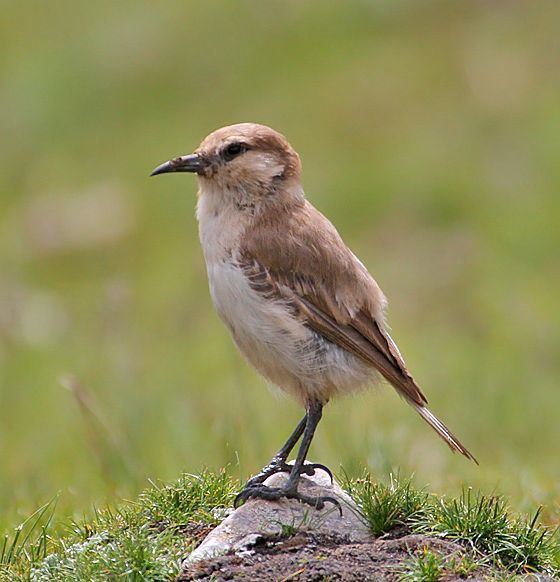Order Passeriformes Scientific name Pseudopodoces humilis Rank Species | Phylum Chordata Family Paridae Higher classification Pseudopodoces | |
 | ||
Genus PseudopodocesZarudny & Loudon, 1902 Similar Bird, Ground jay, Passerine, White‑browed tit, Yellow‑browed tit | ||
The ground tit, Tibetan ground-tit or Hume's ground-tit (Pseudopodoces humilis) is a lark-like bird which lives to the north of the Himalayas. It is also known as Hume's groundpecker. It was formerly thought to belong to the family Corvidae which includes the crows and jays and was called Hume's ground jay or Tibetan ground jay. This species has since been identified as a member of the tit family (Paridae) and is the only species in the genus Pseudopodoces.
Contents
Description
P. humilis is somewhat similar to the unrelated ground jays (Podoces) but much smaller – about the size of a house sparrow (Passer domesticus) – and lacks any conspicuous markings. More strongly however, it resembles a wheatear (Oenanthe) in habitus, but lacks black feathers and has a strong and slightly downcurved bill resembling that of a chough (Pyrrhocorax) in shape (though not in colour). Its soft, lax body plumage is extremely cryptic in its natural habitat. The underside is a greyish-fawn in colour, with a tawny hue. The upper parts are mostly a darker fawn-brown, with the central rectrices and the primary remiges a little darker still; the head is colored like the underside, with a darker cap and light nape patch, somewhat reminiscent of some tits and chickadees, especially those from the genera Parus sensu stricto and Periparus. The bill, legs and feet are black. Males and females look alike.
The voice is described as a plaintive whistling, cheep-cheep-cheep-cheep and it also has a two syllable finch-like call.
Systematics
The ground tit was traditionally considered a relative of the ground jays (Podoces), based on its voice and habits. Its autapomorphies have certainly puzzled 20th century ornithologists, but due to its remote range and nondescript appearance, it was little studied and not suspected to be anything but an aberrant ground jay for more than 100 years after its description by Hume. In 1978 and 1989 however, two studies of its anatomy determined that – although at that time unassignable to any family due to its peculiar adaptations, it appeared that it was not a corvid but a more advanced songbird of the infraorder today known as Passerida.
From 2003 onwards, osteological, mtDNA and nDNA sequence and other biochemical data has firmly allied it with the tits and chickadees (Paridae). In fact, genetic evidence suggests that it is a closer relative of the great tit and its relatives in the genus Parus sensu stricto than the chickadees and their relatives of the genus Poecile.
Ecology
It occurs across the Tibetan Plateau of China and the neighboring areas of western Sichuan and Gansu. The Tibetan ground-tit inhabits open alpine steppe and sometimes more arid regions with small scattered shrubs, rarely if ever occurring lower than 3,000 meters above sea level. It is not found anywhere where dense vegetation (especially trees) predominates. The flight of this bird is not strong and it flies low over the ground preferring to run or jump out of the way if approached which it does very quickly. It moves on the ground in unpredictable hops and bounces which can be quite long – jumps of three times the bird's length are achieved without assistance by the wings – rather than striding or running like Podoces ground jays. Observers have compared the sight of a Tibetan ground-tit moving along to a small greyish-brown rubber ball.
It obtains food on the ground, eating a wide range of arthropod prey, often obtained by probing yak (Bos grunniens) dung and turning it over to flush the prey out. It also peers into rock crevices and into holes in the ground in its search for food. Individuals have been observed to poke mud in and near puddles like hoopoes (Upupa epops); in general the bill is extensively used for digging, much like the similarly-shaped one of the red-billed chough (Pyrrhocorax pyrrhocorax). If chased by a bird of prey or other predator, it will bolt straight down the nearest hole like a rodent until the danger has passed. They are frequently found near colonies of pikas (Ochotona). Though the birds and the mammals probably benefit from each other's vigilance, their association is probably less due to a strong mutualism but rather because both prefer habitat with similar ground cover and soil.
The nest is rather unusual for that of a passerine, being built inside a burrow which the birds excavate themselves. It is usually dug horizontally into a bank or wall of earth, and can reach a depth of 1.8 meters. The nest is placed at the end of this in a small chamber and consists usually just of bit of wool placed onto a grass base. The 4–6 eggs are pure white and the young stay with their parents for some time after fledging; half-grown young are still fed by their parents on occasion as late as August.
The ground tit is not a migratory bird but may descend to lower altitudes in valleys during the winter. In addition to digging nesting burrows, ground-tits frequently dig roosting burrows to use during the coldest months.
